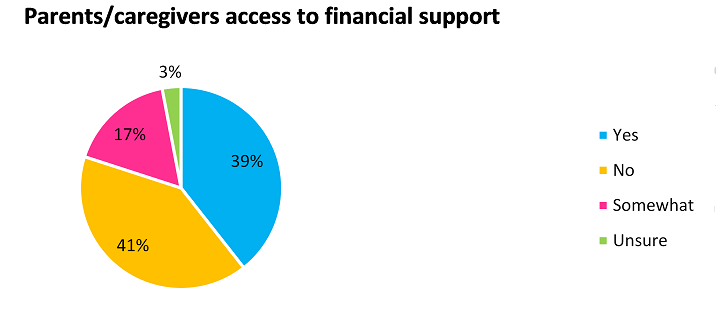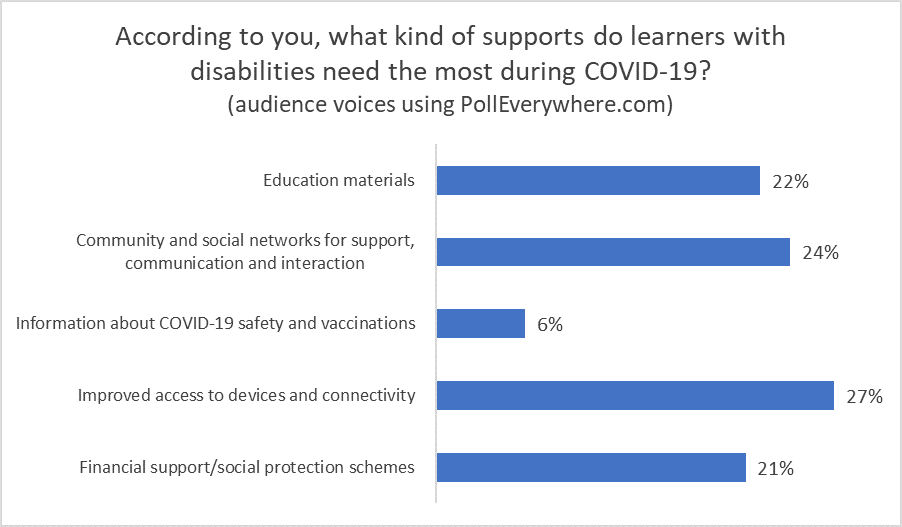The second session presented key preliminary findings from the IEI’s “Learners with Disabilities and COVID-19 School Closure” Survey. The World Bank’s Global Disability Advisor, Charlotte McClain-Nhlapo, presented preliminary data analysis from the 3,994 respondents (parents and caregivers of children with disabilities, teachers of learners with disabilities, and persons with disabilities) that participated in a survey disseminated in May of 2020. The objective of the survey was to understand if learners with disabilities and their families around the world had access to the supports they needed to continue learning while schools were, and still are for many, closed due to COVID-19.
Key findings from the IEI survey include:
Financial security is critical pre-requisite to learning opportunities at the household level. 41% of parents reported having no access to the critical financial supports they needed to support their child’s learning. Close to a third of teachers pointed to “cost” as a key barrier for students with disabilities to access the supports they need. When it comes to creating an enabling home environment for learners with disabilities, financial security is critical and is a prerequisite for effective teaching and learning, particularly for learners with disabilities. This pandemic has only exacerbated the economic hardships that so many were already enduring.

COVID-19 has disproportionally disrupted access to quality learning for learners with disabilities. 58% of respondents are concerned learning lag because of inaccessible distance learning modalities. 1 in 4 parents report lack of internet/data and 23% report lack of device availability. 48% of respondents are concerned that learners with disabilities would not know how to use the technology appropriately to continue their learning. Even parents were concerned with how to use the necessary technology.
Access to a device does not mean meaningful learning. More than 60% of the respondents had access to a TV but less than 20% believed that it was useful for remote learning, especially for learners with hearing and visual impairments. There were gendered differences with respect to device access. Moreover, learners with disabilities were less likely to receive a learning device as compared to their siblings.
“I set up a WhatsApp group and sent out videos to explain the subject matter, translations of the material into the vernacular (Zulu) and worksheets. Initially participation was good, but most parents now say they do not have sufficient data to download the materials I send. Others have said that they often forget to do the homework with their children as they are constantly anxious about their economic survival.”
– Teacher, Sub-Saharan Africa

COVID-19 has increased the risk of social isolation and need for social protection and community support. Learners with disabilities are lacking the socioemotional support to understand and cope with the pandemic. Survey findings show the need of social experiences as much as academic learning. The survey also highlights the increased risk of food insecurity, and violence and abuse at household level.
Overall, respondents were unsatisfied with the local responses to COVID-19 as it concerns learners with disabilities. On a scale of 1-5, more than 85% reported dissatisfaction. They felt as if children with disabilities were an afterthought, despite their increased vulnerability. When asked what they thought about children returning to school, close to 20% had concerns that they would not return, and this was especially so for girls with disabilities.
A report of the findings will be disseminated soon with a deep dive into creating an enabling home environment for learners with disabilities, remote teaching and learning: resources and pedagogies, and addressing the needs of learners with disabilities when returning to school and in future emergency response plans.
According to the workshop participants, when asked “what kind of supports do learners with disabilities needs the most during COVID-19”, it was a pretty even response to the need for “financial support and social protection schemes”, “improved access to devices and connectivity”, “community and social networks for support, communication, and interaction”, and “educational materials”.
